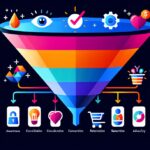How to Make a Marketing Funnel: A Step-by-Step Guide

In today’s competitive digital landscape, businesses face the challenge of converting visitors into loyal customers. With a plethora of options available to consumers at their fingertips, simply attracting visitors to your website is no longer sufficient. This is where a marketing funnel plays a crucial role.
A marketing funnel is an effective tool that allows businesses to visualize and manage the customer journey from the first moment a potential client interacts with a brand to the point of making a purchase. By breaking down the process into distinct stages, companies can implement targeted strategies at each phase to enhance the overall customer experience and maximize conversion rates.
Why Implement a Marketing Funnel?
A marketing funnel helps in organizing your marketing efforts effectively by segregating the potential customers’ journey into different segments. By understanding the stages of a marketing funnel—Awareness, Interest & Desire, and Action—businesses can create and implement strategies that are aimed specifically at guiding potential clients through each phase. This structured approach not only aids in crafting personalized marketing tactics but also ensures consistency in converting leads through the funnel.
For affiliate marketers, especially, understanding how to make a marketing funnel is vital. It helps in managing various aspects such as sales funnels, landing pages, email automation, and customer relationships seamlessly. A robust marketing funnel can help you systematically turn potential customers into actual buyers.
Tools for Crafting Your Marketing Funnel
Creating an effective marketing funnel involves multiple components and stages. Platforms like ClickFunnels, which offer a free trial, serve as a comprehensive solution for building all stages of a marketing funnel. They allow marketers to craft sales workflows, consistent customer engagement points, and efficient conversion paths. ClickFunnels enable you to create complete sales funnels, optimize landing pages for better engagement, automate email sequences, and manage all website elements within a centralized system—making the funnel creation process easier and more streamlined.
Utilizing such tools not only simplifies the creation process but also ensures your marketing activities are cohesive and effective, targeting the right audience at the right time. By leveraging the advantages of these comprehensive tools, you can successfully implement and manage marketing funnels that enhance customer engagement and drive conversions consistently.
Building Awareness: The Top of the Funnel (TOFU)
In the journey of how to make a marketing funnel, the top section, known as the Top of the Funnel (TOFU), is crucial for generating awareness. This initial stage targets a broad audience with the aim of attracting as many potential leads as possible.
Utilizing Social Media Marketing
Social media platforms offer a unique opportunity to reach and engage a wide audience. Crafting posts that are visually appealing and relevant to your audience can significantly boost your brand’s visibility. Sharing content that resonates with the audience’s interests not only draws them in but also encourages them to share, thereby expanding your reach organically.
Leveraging Blog Posts
Blogging is an essential component of the top-of-the-funnel strategy. By producing valuable and informative blog posts, businesses can showcase their expertise and establish authority in their industry. Content should be tailored to answer common questions or solve problems that your target audience faces. Integrating search engine optimization (SEO) techniques ensures that these blogs rank higher on search engines, thereby enhancing their discovery.
Mastering Search Engine Optimization (SEO)
SEO is key to increasing your business’s visibility on search engines and drawing potential customers into the funnel. Focus on using relevant and high-ranking keywords naturally throughout your content. While “how to make a marketing funnel” is your primary keyword, remember to avoid keyword stuffing and maintain content quality. Instead, incorporate synonymous phrases and related keywords within your content to improve SEO while enhancing readability.
Creating Engaging Content
The content you produce needs to be engaging and tailored to the interests of your target audience. This involves understanding their preferences, challenges, and motivations. Whether it’s through instructional videos, infographics, or interactive content, offering valuable insights and solutions captures attention and prompts further exploration of your brand.
Overall, the focus at the TOFU stage is on casting a wide net to catch the attention of a large audience. By employing strategies such as social media marketing, blog posts, and SEO, and by providing engaging content, businesses can effectively draw potential customers into the funnel and set the stage for deeper engagement.
Cultivating Interest and Desire: The Middle of the Funnel (MOFU)
Once your potential customers are aware of your brand, the middle of the funnel (MOFU) becomes crucial in maintaining and deepening their interest in your products or services. The goal at this stage is to nurture leads by providing targeted information that directly addresses their specific needs and challenges.
Strategies for Engaging the MOFU Audience
The MOFU phase is about creating a sustained dialogue with your audience. Tactics such as email marketing, webinars, and informative content can serve as effective methods to communicate the value of your offerings.
Email Marketing: Craft a series of personalized emails that provide value and insight to your subscribers. Use segmentation and automation to send tailored content that resonates with their interests and solves their problems.
Webinars: Hosting live or recorded webinars can provide an interactive platform where potential customers learn more about your products’ capabilities and their applications.
Informative Content: Create rich, engaging content such as case studies, white papers, and how-to guides. These resources can effectively demonstrate the practical benefits and unique features of your offerings.
Personalization and Compelling Calls-to-Action
Personalization and well-crafted calls-to-action (CTAs) are paramount for turning interest into desire. Understand your audience’s pain points and offer solutions tailored to these concerns. Use data insights to customize content and optimize CTAs to encourage further engagement.
Leveraging Tools for Enhanced Engagement
Platforms like ClickFunnels can facilitate the crafting of effective marketing funnels. ClickFunnels simplifies the creation of sales funnels, landing pages, sales workflows, email automations, and websites, enabling you to design and manage all stages of a marketing funnel seamlessly. If you’re looking to enhance your funnel’s performance, consider trying out ClickFunnels with a free trial to experience its powerful capabilities firsthand.
By utilizing these strategies and tools, you can nurture leads efficiently and prepare them for the final conversion phase. In guiding prospects through this nurturing process, you foster a connection that not only addresses their needs but also compels them to consider your products or services as the solution they seek. Keep refining these tactics to ensure continuous engagement and an increased likelihood of conversions.
Closing the Deal: The Bottom of the Funnel (BOFU)
In how to make a marketing funnel, the Bottom of the Funnel (BOFU) is the crucial stage where businesses aim to convert interested leads into paying customers. Here, the focus shifts to addressing any final hesitations prospective buyers may have and providing them with all the necessary tools and information to make a purchasing decision.
Providing Detailed Product Information
A well-informed customer is more likely to make a purchase. At this juncture, it’s essential to offer comprehensive product or service details that highlight the value and benefits your prospects can expect. Include specifications, user guides, and any distinguishing features that set your offering apart from competitors. Detailed content such as videos, demos, and FAQs can be incredibly effective in providing potential customers with the confidence needed to finalize their decision.
Offering Incentives
Incentives like discounts, free trials, and limited-time offers can serve as powerful motivators to encourage prospects to take the leap. These perks not only make your proposition more attractive but also instill a sense of urgency, which can spur quicker decision-making. Tailor these offers to be relevant and attractive to your target audience, ensuring they see genuine value in taking action.
Delivering Exceptional Customer Service
Exceptional customer service can significantly influence the purchase decision. Ensure that your sales and support teams are well-equipped to handle inquiries swiftly and effectively. Providing personalized assistance and addressing any questions or concerns with empathy and clarity can enhance customer satisfaction and close more deals. By delivering a seamless experience, you reinforce trust and rapport with your leads, paving the way to conversion.
Eliminating Objections
Anticipate any reservations your prospects might have and proactively address them. This might involve providing testimonials and case studies that illustrate successful outcomes and satisfied customers. These real-life examples build credibility and show potential buyers how others have benefited from your offerings. Implementing risk-reversal strategies such as money-back guarantees can also alleviate concerns, reassuring prospects of their decision.
Seamless Purchasing Process
The purchasing process should be as simple and intuitive as possible. A complicated or lengthy checkout experience can deter potential buyers. Implement user-friendly cart and payment systems, offer multiple payment options, and ensure that all pages are mobile-optimized. Clear and concise calls to action (CTAs) guide prospects smoothly through to completion, helping to maximize your conversion rates.
Direct Engagement and Sales Consultations
For products or services that benefit from direct engagement, sales consultations can be invaluable. These one-on-one interactions allow for personalized discussions, addressing specific needs and customization requests. Ensure that your sales team is trained to prioritize customer interests, providing solutions rather than hard sells. Engaging sincerely can effectively push interested leads across the finish line, enhancing your overall marketing funnel success rate.
By mastering these BOFU strategies within your marketing funnel, you ensure a higher probability of turning potential leads into loyal customers, thus achieving tangible business growth.
Conclusion: Optimizing and Analyzing Your Marketing Funnel
Creating a successful marketing funnel is not a set-it-and-forget-it task. It requires continuous optimization and analysis to keep pace with market dynamics and the evolving needs of your audience. Regularly evaluating each stage of your funnel allows you to identify performance bottlenecks and areas needing improvement.
To maintain an effective funnel, leverage data analytics and customer feedback. By scrutinizing metrics such as conversion rates at each stage, time in the sales cycle, and customer engagement statistics, you can gain insights into what’s working and what’s not. This data-driven approach enables you to make informed decisions that refine your strategies and enhance the overall experience for potential customers.
Implement A/B testing to compare different approaches and determine which elements yield the best results. This could be in relation to your content, calls-to-action, or even the layout of your landing pages. Furthermore, adjust your communication tactics based on customer behavior and preferences. Personalizing your approach not only improves engagement but also leads to higher conversion rates.
Given the variety of tools required to manage these tasks, a comprehensive platform like ClickFunnels can streamline processes significantly. This platform offers features that aide in the creation of sales funnels, landing pages, and workflows, as well as e-mail automations and websites. Incorporating such a tool allows for smoother management of all funnel stages. For instance, if you’re looking to efficiently craft each part of your marketing funnel, consider exploring a free trial of ClickFunnels. Utilizing robust tools enhances your capability to continuously optimize your funnel strategies.
In conclusion, by thoughtfully addressing the optimization and analysis of your marketing funnel, you ensure that your funnel remains a dynamic tool driving conversions. By staying attuned to audience feedback and utilizing technological solutions, your business can better support long-term growth and sustain competitive advantage in an ever-evolving market.





